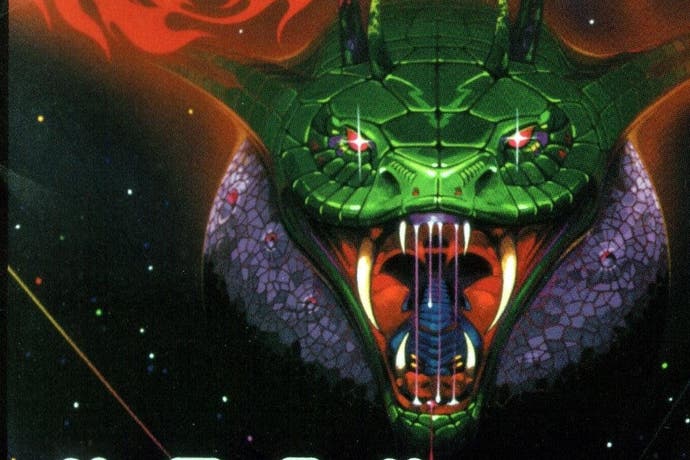The JAMMA bliss of Salamander
Why Konami's Gradius sequel remains an arcade king.
Nearly all retro-heads of a certain age have an enduring romance with the 1980s arcade. We reminisce about the rows of machines blaring out for attention and credits, their screens illuminating a dark cave that smelt of hot electronics, cigarettes and spilt drinks. I increasingly think it sticks in the mind precisely because it had a smell. These days, we have only the scent of a freshly opened game, rather than places of magical discovery and competition. My deepest feelings of arcade romance are for the mid-80s carnival of JAMMA, where the Japanese megabrands such as Sega, Capcom and Konami cemented their growth into industry legends. It really was a splendid time, where new arcade games seemingly arrived on a weekly basis.
The event (and the game) that gave me my love of the arcade happened on a trip to Rollerbury, Bury St Edmunds' premiere roller-skating arena. There was a broken Dragon's Lair and a working Choplifter on the way to the actual arcade, and even though it was nearly 30 years ago, I can still remember most of the machines in that smelly, dark room. It reads like a perfectly curated idea of a cool connoisseur's arcade: Battlezone (broken), Bombjack, Commando, Marble Madness, Centipede, Paperboy and finally, the game that would come to symbolise the JAMMA era for me, Salamander.

Konami's sequel to Gradius stole the show. We'd all played Bombjack and Commando thanks to Elite's decent 8-bit conversions, but Salamander was astonishingly advanced. The splash screen had a fireball that wrapped around an alien logo of Japanese letters. The attract mode showed the wealth of power-ups available and the demo showed AI players coursing through the first stage and later, flying through a burning, boiling star.
Maybe it was the fuzz and glow of the CRT in the darkness, but this one stage (officially named Burning Chaos - Fire Prominence Zone) redefined the limits of video game graphics for me. Even now, it sums up the magic of the JAMMA era's visual splendour just as well as Sega's sky gradients. The palette is filled with rich oranges and yellows and the pixel art is fabulously detailed. Fiery enemies emerge to assault you and the star itself shoots arcing bursts of plasma in a wonderful example of how environment, as distinct from enemies, becomes a spectacular challenge. It was amazing to witness.
"Salamander has a peculiar vibrancy and originality that seems a step away from Gradius's main thread."
Ocean handled a C64 conversion of Salamander, treading the often rocky path of 8-bit ports. Sometimes they were like vague gestures towards the real thing, and sometimes they were surprisingly faithful. Gauntlet was excellent, for example, while Outrun was a bit lacking. By this time, I'd played Simon Pick's fantastic C64 version of Gradius (going by its UK name, Nemesis), and seeing the screens of Salamander printed in Zzap 64 caused quite the stir. Bob Stevenson was doing the graphics. The Bob Stevenson, a noted C64 artist who'd grown from an embryonic UK demoscene debutante to a master of the stunning loading screen. He was one of a handful of virtuoso C64 artists and for my money, he was the very best. I couldn't be more excited. When the game finally arrived, it turned out to be remarkably accurate, save for missing the simultaneous two-player mode and, regrettably, a few levels - though that all-important third stage was intact.

Salamander occupies a weird place in the Gradius lineage. Its departure from the signature power-up regime (allowing instant power-ups rather than saving up to select from a menu) seemed to mark it out as fundamentally different somehow, but it's still my favourite of the series. It's due partly to the game's willingness to pile on the power-ups, giving you all the missiles, lasers and options you need for the entire game from the start of the first stage, which makes for great fun from the off. But mostly, it's down to that visual flair and imagination.
Salamander has a peculiar vibrancy and originality that seems a step away from Gradius's main thread. The first stage has you flying through a giant alien's guts, and darting around colossal talons, to shoot its one-eyed and double-clawed brain. R-Type may symbolise the bio-organic style for many, but Salamander clearly did it earlier, and with considerable panache. Then there's the shifts in orientation. It came as quite a surprise when stage two started as a vertical shmup, and while stage three represents the pinnacle of Salamander's visual artistry, it keeps up a steady flow of beautiful scenes right to the end of the arcade version. The action is also tight as hell, and traditionally unfair at times, but the shifts to vertical highlight how well the Gradius system would work in a modern vertical shooter, should Konami ever dare to pick up the torch that Treasure carried so magnificently with Gradius 5.
But there's that C64 conversion too. It symbolised something bigger to me, that home machines were going to match the arcade and, possibly, beat them. The arcade version is obviously the most beautiful, and it's still deliciously vibrant to watch today. It's well worth a spin in MAME with the cheats turned on, just to tour its stages and see Vic Viper from a different perspective. As a symbol of the JAMMA era and a reason to still be in love with it, Salamander keeps the fire burning perfectly well.

